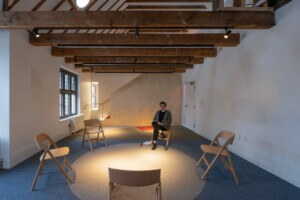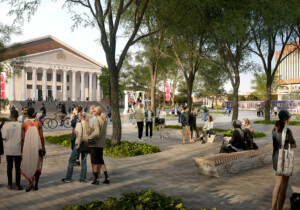With its recently-completed $1 billion expansion to the University of Southern California (USC) in Los Angeles campus, the architecture firm Harley Ellis Devereaux (HED) has taken a definitive stance in the ongoing debate over resurgent neo-traditionalism in architecture by cloaking a strikingly contemporary complex behind filigree and lace.
The 1.25-million-square-foot USC Village is spread across six Collegiate Gothic–style buildings on a site occupying the former University Village, a 1960s-era student-geared retail site that was recently purchased and torn down by the university. The new USC Village houses eight residential colleges, an 8,000-square-foot dining hall, a campus power plant, 130,000-square feet of retail spaces, and 2,500 beds of student housing spread across a six courtyard structures that surround a collection of retail-lined plazas and paseos.
Initially, USC planned to have a traditional developer sign a long-term lease for the right to build on the site. The arrangement would have probably yielded, according to Mark Skiles, project architect at HED, a typical stick frame commercial complex designed to last only long enough for the developer to net a profit. Instead, the university opted to develop the property for itself, treating the project not just as a shiny and new student amenity, but as a full-fledged campus expansion.
The change in vision resulted in a conceptual shift for the architecture, as well. “These are 100-year buildings,” Skiles explained while touring the site with The Architect’s Newspaper (AN). “They are concrete frame construction.”
The shift in construction technique—which comes with a slew of particular qualities different from those of stick frame construction—results in significant shifts to the prototypical architectural qualities of the complex. For one, the buildings stand taller and prouder than would normally be the case: concrete construction typically yields floor-to-floor heights of 10 feet, 9 inches that net dorm dwellers roughly an extra foot of overhead space over traditional stick frame construction. This results in taller buildings, overall. The 60-foot-tall blocks cast deep, cooling shadows on the hardscaped spaces between the buildings. Los Angeles–based landscape architecture firm RELM—formerly Melendrez—has successfully planted these areas with fine sycamores that will grow to stately heights in coming years. A central bosque adjacent to the main plaza—which will eventually be populated with benches and umbrellas—serves to cool the main square and aligns with one of the university’s main axes, mirroring the tree allées across the street on the main campus.
The construction method is also reflected on the building’s panelized facades which were manufactured offsite and craned into place. The brick veneer-faced panels were fabricated by contractor Hathaway Dinwiddie in reverse order, with a layer of ⅝-inch brick veneer arranged in a mold that was then filled in with cement. The architects designed 80 unique panel types for the project. Protrusions covering the facades—sandstone-colored concrete tracery, window aprons and frames, and swept cornicework—serve to hide the seams between each panel in plain sight. The stylistic treatment—a requirement set by the client, who wanted to instill a sense of “history” on the 137-year-old university—elaborately invented as it may be, is a tour de force in contemporary construction practices. As such, sometimes these efforts are a bit ham-handed, especially along many of the windows, where awkward, cross-shaped concrete muntins stand proud of run-of-the-mill window frame assemblies. This detail of “old” architecture physically draped over modern construction is repeated throughout the complex, to sometimes great effect.
The entry sequence at USC Village on Hoover street—the main community and parking entrance—suffers, however, from the blended approach. There, a large, overwrought gothic triumphal arch swallows cars underground, effectively disrupting the sidewalk with its wide ramp. The move is congruous with the university’s uneasy community connections, including the need to close off and secure the campus. The omnipresent gates and entry kiosks can lend a hostile nature to the overall scheme.
In other places, however, the details shine by deploying a consistent material and tectonic methodology that renders a great deal of relief to each facade and throughout the complex. The sandy-colored arched colonnades lining the courtyard, for example, are supported by the structure’s real concrete columns, not hollow concrete veneer tubes as might be the case in typical revivalist construction. The over-sized arches rest on squat, 18-inch thick Romanesque-style columns that were cast in circular footprints in order to be expressed in an evocative style, simultaneously revealing and obscuring the true scale of the building’s structural system. Behind the concrete panel arches above, furred-out soffits contain prosaic components like lighting and sensors that terminate in expanses of curtain wall. Like other aspects of USC Village, what you see is what’s there—the architects make little effort to hide the contemporary nature of their buildings.
The aesthetic treatment for the project is interesting because it combines, in bits and pieces, symbolic elements of its derivative style from primary and secondary sources alike. The mess hall, which features a soaring wooden roof studded with dormer windows, for example, is inspired equally by Christ Church at Oxford University and Hogwarts Castle, according to the architects. The blend is not necessarily notable given the Los Angeles context, where historically-speaking, paper and white-wash pass for architecture more often than not. It is inventive nonetheless because those vernacular proclivities are blended by the designers toward creating a built language that is rooted not simply in image-based reference, but in surface relief and construction detail alike. Here, for example, lateral structure convincingly populates the ceilings of the clear-span space, adding detail and texture despite the chunky candelabra and the building’s overall squat proportions.
Successful too are the student lounge courtyards that punctuate each residential college. Decked out in trees and planters, the spaces feel comfortable and useful all at once and provide necessary social and green spaces accessible to dorm rooms. Again, when the trees grow in, these spaces will be beautiful.
Overall, the complex works as an exploration of how traditional style can be explored with a contemporary construction vocabulary. Regardless of whether the buildings lend today’s USC an air of much-sought “history,” one thing is for sure: like the original examples of their style, these Collegiate Gothic edifices will be around for a long time.










